It is well-established in the 21st century that Data is the most important asset of any digital organization. Top CXOs agree that their organization’s data is mostly an untapped asset, and they can extract way more value from it by using intelligent systems. Current digitization efforts have just scratched the surface of this value by mostly delivering automation to make human jobs faster. True intelligence will be when we take a data-centric mindset and adopt the philosophy of data-as-a-product. Most automation efforts usually focus on converting raw data into structured information that can be presented to humans as dashboards or alerts. However, information extraction is just the first step in the data value creation journey.
Decoding the DIKW Model by J. Rowley
The popular wisdom hierarchy originally proposed by J. Rowley talks of a knowledge pyramid (shown in the figure below) where the value derived from data increases as we move upwards to information, knowledge and maximizes if we can extract wisdom. So, what differentiates these terms? We know data is in raw format as numbers, images or text that needs to be structured into information to be shown on dashboards and consumed by analytics. Knowledge adds value of relationships to information. If we can establish relationships like a bank is a subsidiary of a conglomerate or a drug is upregulating specific genes – these relationships help build knowledge that can be used to make better decisions. The knowledge can be either extracted from data or entered manually by domain experts. Knowledge will make our analytics and ML models better but true value will be when the analytics can tell us what to do. This is the wisdom that recommends the ‘next best action’ to us.

Moving Up the WKID Pyramid
An organization can get mature by moving up the WKID pyramid. It can move beyond automation, start building intelligent systems and assist in human decision making. What we are effectively doing as we move up the pyramid is making our software and systems smarter which in-turn increases their complexity. It is relatively easy to build a dashboard of stock prices from several companies, show statistical summaries from historical data and let the analyst draw necessary inferences like where to invest. However, if we really want to go to the next level and analyze the relationships between stock prices of companies and macro-economic factors – it’s a far more complex, albeit a very rewarding problem to solve. This is where technologies like AI and Machine Learning shine to capture patterns and relationships in data. Ultimate objective should be to make systems intelligent and autonomous to provide actionable insights to humans.
Use Case – From Data to Actionable Insights
Let’s take an example of a Tax Software company that calculates taxes on transactions collected from users. They need information on latest tax regulations which is usually published on government websites as tax bulletins. They would typically build a system using Natural Language Processing (NLP) models that scrapes tax websites, parses tax bulletins, extracts taxation percentages for different regions and presents this information to tax experts. This is very helpful but it’s just the beginning of automation and you leave most of the intelligence to be executed by a human. A more mature system would capture the relationships between taxation entities and build a knowledgebase of rules. Knowledge is the next maturity level where you store the context for the information – items like jurisdiction, products, percentages, applicable time and more.
More complex ML models are needed to capture this knowledge often requiring deep learning techniques. With this upgrade, tax experts do not need to manually go and check all calculations that need updating. The relationships captured in the knowledgebase can help query impacted calculations and even perform the update. Next level of smarts will be when the system can provide recommendations for tax categorization and save money for the end user.
This could be done by trying out several strategies, ‘what-if’ scenarios and learning from other peoples’ tax filing patterns. Mining this wisdom to provide actionable insights requires lot better algorithms and processing much more volume of data. These models often need heavy customization and you may have to look at a model-of-one paradigm. It is an initial investment but can truly provide value for the organization and be a differentiator in the long run.
Today, many digital organizations have started the journey towards building knowledge platforms to supplement their digital systems. Persistent’s knowledge platform offerings can help organizations move up the WKID pyramid and transform their automation systems into intelligent systems that provide actionable insights. To explore how our Artificial Intelligence & Machine Learning offerings can add value to your business, connect with us at: airesearch@persistent.com






